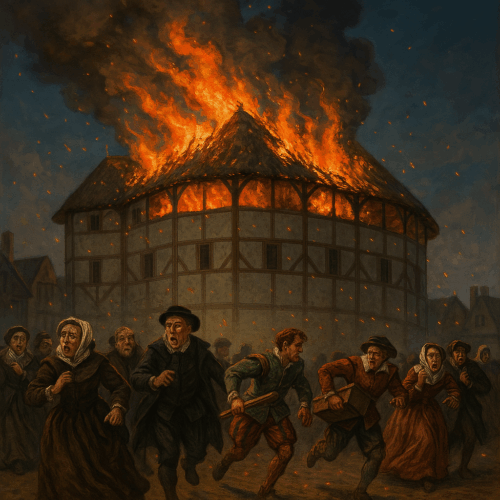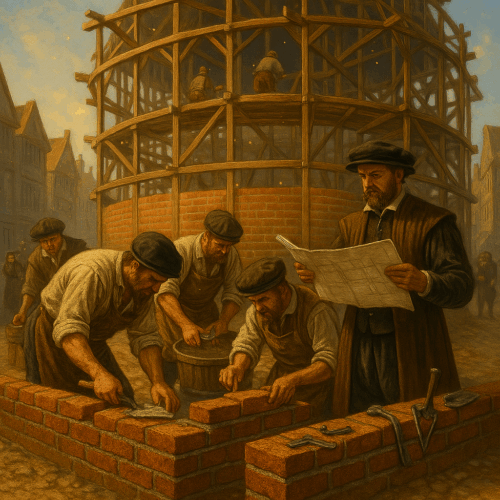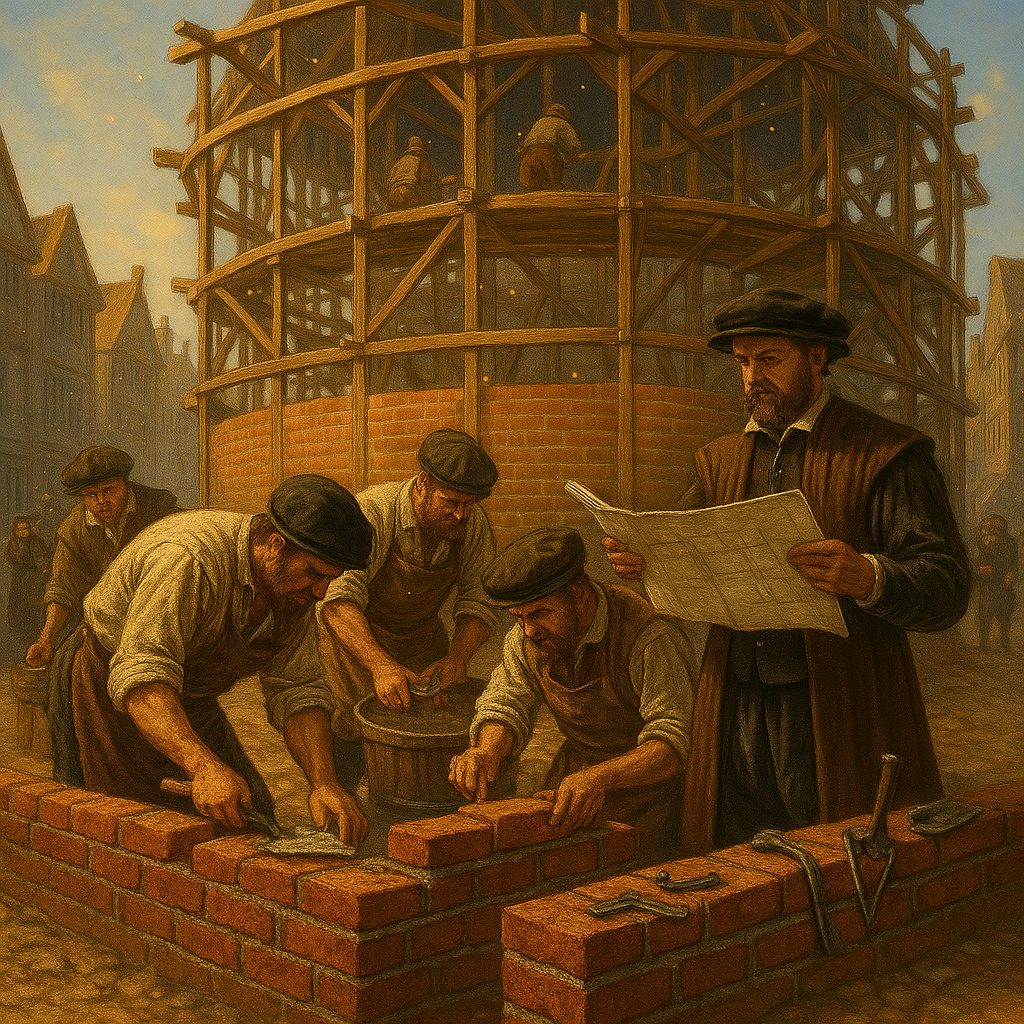On June 29, 1613, London’s iconic Globe Theatre—home to Shakespeare’s greatest dramas—erupted into a spectacular blaze. A cannon fired during a performance of Henry VIII ignited the thatched roof, sending wooden beams and joyous spectators aflame. Within an hour, the legendary stage lay in smoking ruin, its actors and audience stunned by the sudden catastrophe. Yet from those smoldering timbers emerged one of history’s greatest comeback stories—a testament to adaptability, optimism, and creative reinvention that still holds lessons for us today.
—
## A Fiery Catastrophe with Silver Linings
Imagine the roar of the crowd, the crack of a stage cannon, then an explosion of sparks high above the spectators’ heads. The Globe’s wooden galleries, pieced together by local carpenters and thatchers, were never meant to withstand explosive special effects. In a flash, the theatre’s thatched roof became tinder, rain of embers fell on the groundlings below, and the performance halted in chaos. Miraculously, no one was killed, but the building was a total loss.
The community rallied immediately. Patrons donated money, carpenters and craftsmen offered their skills, and within a year the Globe rose again—stronger, safer, and more luxurious. Its brick foundation replaced much of the wood, and the roof received a fireproof tile covering. Shakespeare and his company used the hiatus to refine new plays, experiment with staging, and strengthen their brand. What seemed like an irreparable disaster became a launchpad for innovation and growth.

## Why the Blaze Was a Blessing in Disguise
In the aftermath, the Globe company could have folded. They could have surrendered to fear of future mishaps and retreated into safer, smaller venues. Instead they seized the opportunity to reimagine everything—from architecture to programming:
– Rebuilt with fireproof materials and improved exits
– Enhanced acoustics and sightlines in the new design
– Introduced premium seating tiers for better revenue
– Commissioned new plays to mark their triumphant return
This mindset—transforming a calamity into a springboard for change—is the same blueprint for anyone facing unexpected setbacks. The Globe’s leadership asked: “How do we come back not just intact, but better?”
—
## Resilience: The Core of the Shakespearean Comeback
At its heart, the Globe’s recovery was about resilience: the ability to absorb damage and still move forward. They didn’t pretend the fire never happened; they learned from it:
- **Acknowledgment:** Admitted the theatre’s vulnerabilities openly.
- **Collaboration:** Engaged patrons, artisans, and investors in rebuilding.
- **Innovation:** Explored new materials (tile, brick) and safety features.
- **Refinement:** Took time offstage to develop content and strategy.
Because they treated the blaze as data—evidence of weaknesses—they emerged with a blueprint for lasting improvement.

## From Fire to Fortune: Applying This Lesson Today
We all encounter our own “Globe fires”—career derailments, relationship breakdowns, financial setbacks. Here’s how to channel Shakespeare’s spirit in your own life:
- **Diagnose the Burn:** Identify exactly what went wrong—was it a communication lapse, a technical failure, or a flawed process?
- **Assemble Your Guild:** Reach out to mentors, friends, or colleagues who can provide expertise, encouragement, or resources.
- **Invest in Fireproofing:** Upgrade your skills, tools, or systems so that future failures have less impact.
- **Draft a New Script:** Use recovery time to refine your strategy—learn a new skill, pivot to a fresh niche, or prototype an innovative project.
- **Celebrate the Reopening:** When you relaunch, mark the occasion—share your story, gain visibility, and invite supporters back in.
These steps mirror the Globe’s transition from disaster to renaissance and ensure setbacks fuel long-term success.
—
## A Personal Action Plan: 6 Steps to Your Renaissance
Let’s distill these takeaways into a concrete six-week plan you can start today:
**Week 1: Fire Assessment**
– Journal the setback in detail: timeline, causes, emotions.
– List three “lessons learned” and one question you need answered.
**Week 2: Network Activation**
– Identify five individuals—mentors, peers, or experts—who’ve weathered similar storms.
– Send personalized messages asking for one specific piece of advice.

**Week 3: Skill Fortification**
– Choose one skill or tool that would mitigate future risks (e.g., project management software, a certification).
– Enroll in a workshop or online course and dedicate three one-hour sessions.
**Week 4: Strategic Pivot**
– Brainstorm five new approaches or projects inspired by your fire assessment.
– Select one to prototype with a simple MVP (minimum viable product) or outline.
**Week 5: Prototype and Test**
– Create your MVP or draft a sample proposal.
– Solicit feedback from your network guild.
**Week 6: Grand Reopening**
– Plan a “launch event”—a blog post, a presentation, or a social media campaign.
– Highlight your story of transformation, the new safeguards you’ve implemented, and next steps.
—
## Why This Works: Psychology of Reinvention
Human brains are wired to avoid pain—and failure stings. But by reframing a setback as “feedback,” we shift from fear to curiosity:
– **Growth Mindset:** Embrace challenges as opportunities to learn, rather than threats to your identity.
– **Momentum Building:** Small wins in skill-building and planning fuel confidence to tackle bigger goals.
– **Social Proof:** Sharing your journey invites accountability and encouragement, boosting motivation.
This cycle of learn–build–share mirrors the Globe’s blueprint and can power breakthroughs in careers, relationships, and creative endeavors.
—
## Beyond the Blaze: Stories of Modern Renaissance
Just as Shakespeare’s troupe rebuilt, countless individuals and companies have pivoted from ruin to success:
– **Airbnb:** Initially a struggling startup that pivoted from selling cereal to home-sharing—now a global travel brand.
– **Oprah Winfrey:** Overcame early broadcasting setbacks to build a media empire founded on authenticity and resilience.
– **J.K. Rowling:** Went from financial hardship and multiple rejections to creating the world’s bestselling fantasy series.
Each case embodies our six-week plan—assess, network, fortify, pivot, prototype, relaunch—reminding us that resilience isn’t magic, it’s methodical.

## Your Encore Awaits
Whether you’re rebuilding after a missed promotion, a partnership that faltered, or a creative block, the Globe’s saga shows us how to transform ashes into artistry. Embrace these essentials:
– Treat setbacks as strategic intelligence.
– Rally your community for co-creation.
– Reinforce weak spots with targeted learning.
– Prototype boldly, share authentically.
– Celebrate every milestone and recalibrate.
By following this blueprint, you’ll not only recover—you’ll reinvent yourself on a grander stage.
—
## Where the Images Go
- **Image 1** (Globe ablaze) – After the catastrophe description.
- **Image 2** (Rebuilding foundations) – After “Why the Blaze Was a Blessing in Disguise.”
- **Image 3** (Personal mapping) – At the end of Week 2 in the action plan.
- **Image 4** (Modern entrepreneurs) – After “Stories of Modern Renaissance.”
- **Image 5** (Your Encore Awaits) – A final ultra-realistic image of an empty theatre with spotlight on a single actor, placed right before the conclusion.

## Extra Encores You Might Love
– A podcast series on historical comeback stories—learn how ancient figures reinvented themselves.
– A journaling template for “Setback to Strategy,” pairing prompts with weekly check-ins.
– A mini-course on storytelling for resilience: crafting and sharing your journey to galvanize support.
Embrace every challenge as your personal Globe fire—and get ready to thrill your world with an unforgettable second act.

